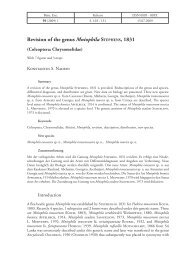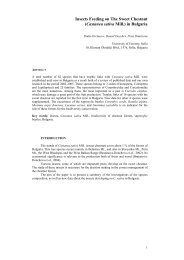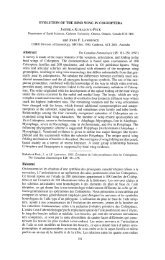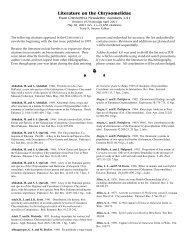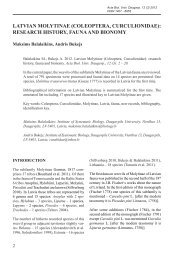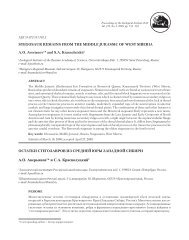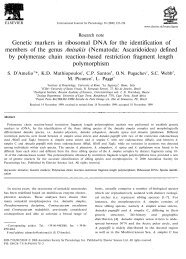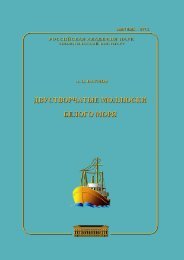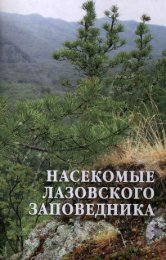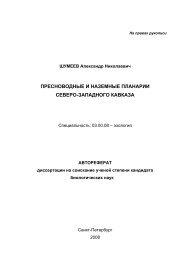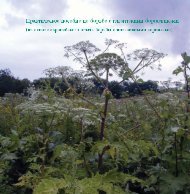International Meeting on Biology and Systematics of Staphylinidae
International Meeting on Biology and Systematics of Staphylinidae
International Meeting on Biology and Systematics of Staphylinidae
Create successful ePaper yourself
Turn your PDF publications into a flip-book with our unique Google optimized e-Paper software.
22nd <str<strong>on</strong>g>Internati<strong>on</strong>al</str<strong>on</strong>g> <str<strong>on</strong>g>Meeting</str<strong>on</strong>g> <strong>on</strong> <strong>Biology</strong> <strong>and</strong> <strong>Systematics</strong> <strong>of</strong> <strong>Staphylinidae</strong> 2007 – abstracts<br />
latter species overwinters in subterranean nests <strong>of</strong> mammals, moles in particular, <strong>and</strong> I collected<br />
a single specimen <strong>of</strong> it. It is the sec<strong>on</strong>d record <strong>of</strong> T. rufipennis in Belarus. Formerly the<br />
species was recorded in the north <strong>of</strong> Belarus, in Vitebsk regi<strong>on</strong>.<br />
The species compositi<strong>on</strong> <strong>and</strong> the dominance structure <strong>of</strong> staphylinids differed c<strong>on</strong>siderably<br />
between the Upper <strong>and</strong> Middle Neman <strong>and</strong> between open <strong>and</strong> forested habitats. The<br />
most diverse staphylinid assemblage, 38 species, was found at floodplain meadows in the<br />
Middle Neman. Four <strong>of</strong> those species were dominants [Xantholinus dvoraki Coiff., Lathrobium<br />
impressum Heer, Carpelimus corticinus (Grav.), Aleocharinae gen. sp.]. Only 21 species<br />
were recorded in floodplain oak forests, also with 4 dominants [Gyrohypnus angustatus<br />
Steph., Anthobium atrocephalum (Gyll.), Geostiba circellaris (Grav.)]. Abundance <strong>of</strong> the eurytopic<br />
hygrophilous Drusilla canaliculata accounted for more than 25% <strong>of</strong> specimens collected<br />
there.<br />
The highest species numbers in the Upper Neman were found in the black alder forest –<br />
33, with 6 dominant species [Ocypus nero (Fald.), Quedius fuliginosus (Grav.), Stenus humilis<br />
Er., Ischnosoma splendidulum (Grav.), Tachinus corticinus Grav., Tachinus signatus Grav.].<br />
Only 22 species were found in meadows there, also with 6 dominants [Gabrius breviventer<br />
(Sperk), Staphylinus erythopterus L., Stenus circularis Grav., Stenus juno (Payk), Anotylus<br />
rugosus (F.), Mycetoporus lepidus (Grav.)].<br />
The highest similarity both in the qualitative data <strong>and</strong> in the species compositi<strong>on</strong> was<br />
discovered between assemblages from the open <strong>and</strong> forested habitats independently <strong>of</strong> assemblage<br />
locati<strong>on</strong> in the Upper or Middle Neman. As it was pointed out above, the similarity degree<br />
<strong>of</strong> the staphylinid assemblages in all sites was low <strong>and</strong> did not exceed 20 – 25%.<br />
The structure differentiati<strong>on</strong> <strong>of</strong> staphylinid assemblages in the floodplain ecosystems <strong>of</strong><br />
Neman <strong>and</strong> Shchara rivers shaped primarily by the degree <strong>of</strong> floodplain development. In the<br />
Upper River courses, in the poor developed floodplain the structure <strong>of</strong> staphylinid assemblages<br />
is very similar to the structure in the surrounding l<strong>and</strong>scape elements. Instability <strong>of</strong><br />
hydrological regime determines the prevalence <strong>of</strong> hygrophilous elements in comparis<strong>on</strong> to the<br />
lower river courses. In the lower river courses, staphylinid assemblages more stable in terms<br />
<strong>of</strong> species compositi<strong>on</strong> <strong>and</strong> ecological structure are observed under c<strong>on</strong>diti<strong>on</strong>s <strong>of</strong> developed<br />
floodplains. Meadow beetle assemblages include mesoxerophilous <strong>and</strong> even xerophilous elements<br />
inhabiting open drier patches in the floodplains, characterized by warmer temperature<br />
c<strong>on</strong>diti<strong>on</strong>s during the summer period. Forested ecosystems in floodplains are characterized by<br />
mixed structure <strong>of</strong> staphylinid assemblages, which include typical forest elements <strong>and</strong> species<br />
<strong>of</strong> open areas. This mixed structure is caused by large-scale mosaics <strong>of</strong> the forested biotopes<br />
in the floodplains in Middle Neman <strong>and</strong> in Low Shchara <strong>and</strong> by development <strong>of</strong> ecot<strong>on</strong>e effects<br />
here.<br />
Thus, in the floodplains <strong>of</strong> the flatl<strong>and</strong> forest z<strong>on</strong>e rivers like Neman or Shchara, the<br />
structure <strong>of</strong> staphylinid associati<strong>on</strong>s is relatively homogeneous al<strong>on</strong>g the spatial gradient from<br />
the river source to the mouth <strong>and</strong> is determined by local habitat mosaic. C<strong>on</strong>siderable changes<br />
in the associati<strong>on</strong>’s structure take place under the influence <strong>of</strong> large-scale mosaic <strong>of</strong> adjacent<br />
to floodl<strong>and</strong>s l<strong>and</strong>scapes.<br />
Acknowledgements:<br />
I am grateful to:<br />
Belarussian Republican Foundati<strong>on</strong> for Fundamental Research for financial support <strong>of</strong> the study;<br />
German Research Foundati<strong>on</strong> (DFG) for financial support <strong>of</strong> my participati<strong>on</strong> in the 22th <str<strong>on</strong>g>Meeting</str<strong>on</strong>g> <strong>on</strong><br />
<strong>Staphylinidae</strong>;<br />
my colleagues from the Institute <strong>of</strong> Zoology for help in organizati<strong>on</strong> <strong>of</strong> field studies <strong>and</strong> technical assistance<br />
in the collecting <strong>of</strong> beetles.<br />
__________________________________________________________________________________________<br />
Staatliches Museum für Naturkunde Stuttgart 9




